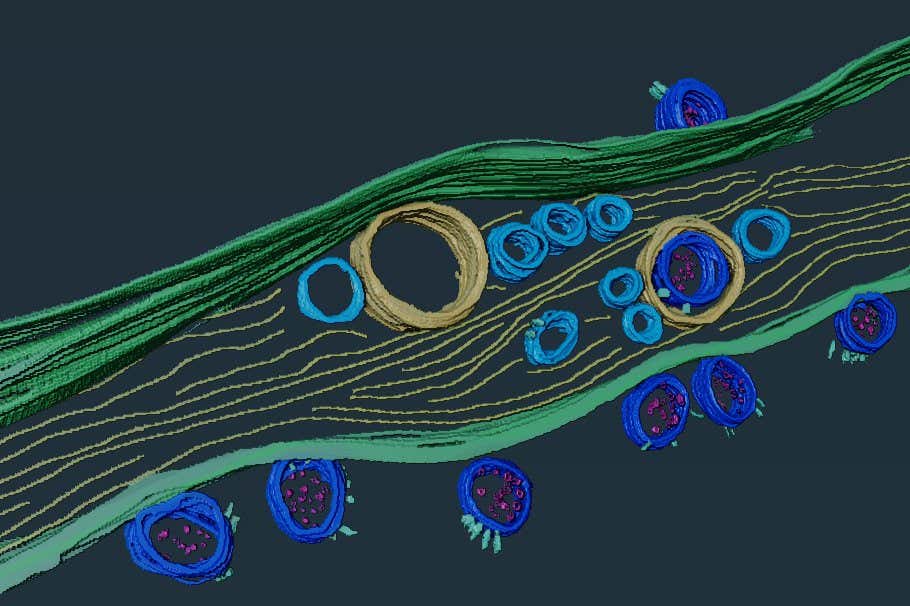How the virus behind covid-19 enters the brain was somewhat of a mystery, but new evidence hints it may build tiny tubes from nose cells to brain cells that it can shuttle through.



This Video Explains Lactic Acid Fermentation.
Lactic acid fermentation is a metabolic process by which glucose or other six-carbon sugars (also, disaccharides of six-carbon sugars, e.g. sucrose or lactose) are converted into cellular energy and the metabolite lactate, which is lactic acid in solution.
Thank You For Watching.
Please Like And Subscribe to Our Channel: https://www.youtube.com/EasyPeasyLearning.
Like Our Facebook Page: https://www.facebook.com/learningeasypeasy/
Join Our Facebook Group: https://www.facebook.com/groups/460057834950033
Support Our Channel: https://www.patreon.com/supereasypeasy

Staff Scientist Daniele Filippetto working on the High Repetition-Rate Electron Scattering Apparatus. (Credit: Thor Swift/Berkeley Lab)
– By Will Ferguson
Scientists have developed a new machine-learning platform that makes the algorithms that control particle beams and lasers smarter than ever before. Their work could help lead to the development of new and improved particle accelerators that will help scientists unlock the secrets of the subatomic world.

According to traditional thinking, distorting a flat space by bending it or stretching it is necessary to create a curved space. A group of scientists at Purdue University has developed a new technique for making curved spaces that also provides the answer to a physics mystery. The team has developed a method using non-Hermiticity, which occurs in all systems coupled to environments, to build a hyperbolic surface and a number of other prototypical curved spaces without causing any physical distortions of physical systems.
“Our work may revolutionize the general public’s understanding of curvatures and distance,” says Qi Zhou, Professor of Physics and Astronomy.
“It has also answered long-standing questions in non-Hermitian quantum mechanics by bridging non-Hermitian physics and curved spaces. These two subjects were assumed to be completely disconnected. The extraordinary behaviors of non-Hermitian systems, which have puzzled physicists for decades, become no longer mysterious if we recognize that the space has been curved. In other words, non-Hermiticity and curved spaces are dual to each other, being the two sides of the same coin.”

Targeted repairs with ‘nicks’ of single DNA
DNA, or deoxyribonucleic acid, is a molecule composed of two long strands of nucleotides that coil around each other to form a double helix. It is the hereditary material in humans and almost all other organisms that carries genetic instructions for development, functioning, growth, and reproduction. Nearly every cell in a person’s body has the same DNA. Most DNA is located in the cell nucleus (where it is called nuclear DNA), but a small amount of DNA can also be found in the mitochondria (where it is called mitochondrial DNA or mtDNA).

People who have at least two of the conditions type 2 diabetes, heart disease, or stroke are twice as likely to develop dementia. Research from Sweden’s Karolinska Institutet that was published in the journal Alzheimer’s.
Alzheimer’s disease is a disease that attacks the brain, causing a decline in mental ability that worsens over time. It is the most common form of dementia and accounts for 60 to 80 percent of dementia cases. There is no current cure for Alzheimer’s disease, but there are medications that can help ease the symptoms.
US Rep Jason Crow, of the US House Intelligence Committee, warned that bio-weapons are being made that use a target’s DNA to only kill that person at a security forum on Friday.

Microsoft has chosen to add specific security measures against brute force attacks against RDP (Remote Desktop Protocol). These security improvements have been introduced in the most recent builds of Windows 11. Given the evolution of this type of attack abusing RDP, Microsoft decided to add the security measure in the latest Insider Preview22528.1000. This system automatically locks accounts for 10 minutes after 10 invalid login attempts. The news was broken by David Weston (VP of OS & Enterprise Security) on Twitter last week.
These kinds of attacks against RDP are quite common in human operated ransomware. With this relatively simple measure, it is possible to complicate brute force attacks, being quite effective in discouraging them. However, it was already possible to activate this measure in Windows 10, so the novelty is really enabling it by default.
On the other hand, it is expected that, as happened with the blocking of VBA macros for Office documents, it will also be implemented for previous versions of Windows and Windows Server. Aside from malicious macros, brute force RDP access has long been one of the most popular methods used in cyberattacks. This strategy was successful in gaining initial unauthorized access to Windows systems. Among other ransomware, LockBit, Conti, Hive, PYSA, Crysis, SamSam, and Dharma are known to rely on these types of attacks to gain initial access to victims’ computers.